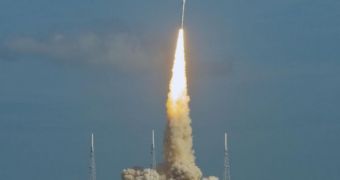Though some experts argued yesterday that the new suborbital test flight for the American space agency's ARES I-X rocket was not a complete success, the reality couldn't be farther from the truth, NASA says in a press release on its official website. According to the notice, the two-minute powered flight went on according to plan, and the booster dropped in the Atlantic Ocean – some 150 miles downrange from the Kennedy Space Center – supported by its parachutes.
“This is a huge step forward for NASA's exploration goals. Ares I-X provides NASA with an enormous amount of data that will be used to improve the design and safety of the next generation of American spaceflight vehicles – vehicles that could again take humans beyond low Earth orbit,” NASA Headquarters Exploration Systems Mission Directorate Associate Administrator Doug Cooke explains.
“The most valuable learning is through experience and observation. Tests such as this – from paper to flight – are vital in gaining a deeper understanding of the vehicle, from design to development,” Ares I-X Mission Manager Bob Ess adds. It took less than three years for ARES I-X to become reality.
According to the technical specifications, the new rocket produced about 2.6 million pounds of thrust upon lift-off, all from its four live segments, in the first stage. The fifth segment was a dummy payload, as was the entire upper stage of the 327-foot (100-meter) test vehicle. The shuttle-derived engines ensured an acceleration of up to 3Gs, and Mach 4.76. The two stages separated at an altitude of about 150,000 feet and the first stage then came down in a controlled manner. The upper stage fell uncontrolled, and sank in the Atlantic Ocean.
“Wednesday's flight offered an early opportunity to test and prove hardware, facilities, and ground operations – important data for future space vehicles. During the flight, a range of performance data was relayed to the ground and also stored in the onboard flight data recorder. The 700 sensors mounted on the vehicle provide flight test engineering data to correlate with computer models and analysis,” the press release adds.
“The rocket's sensors gathered information in several areas, including assembly and launch operations, separation of the vehicle's first and second stages, controllability and aerodynamics, the re-entry and recovery of the first stage and new vehicle design techniques,” the note concludes.

 14 DAY TRIAL //
14 DAY TRIAL //